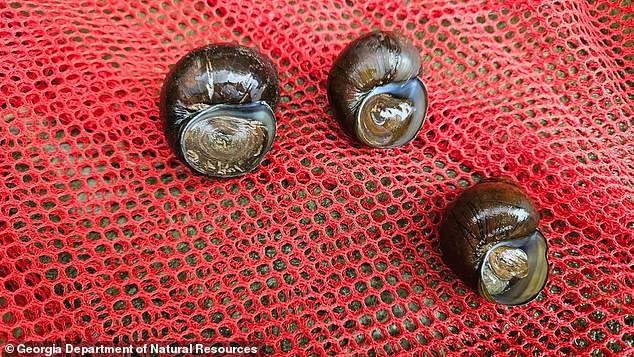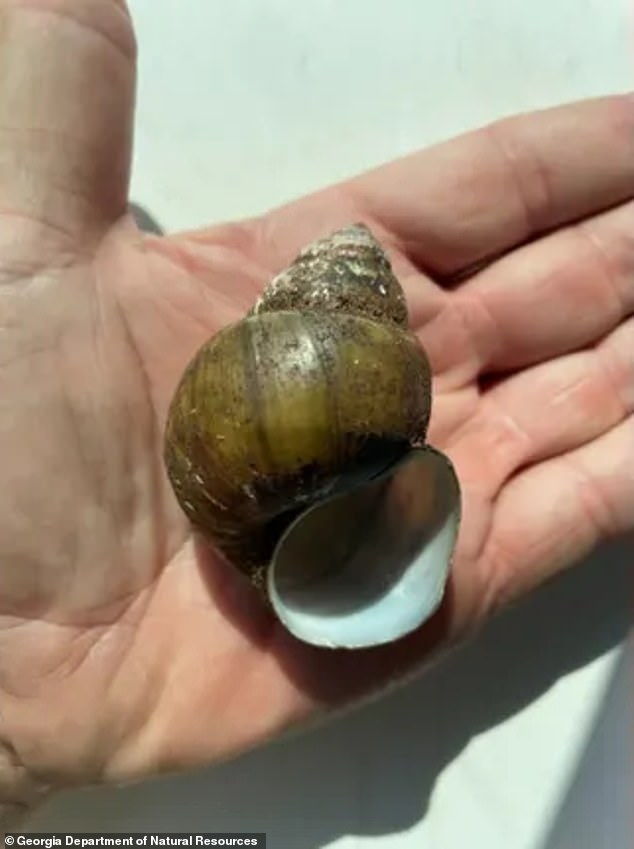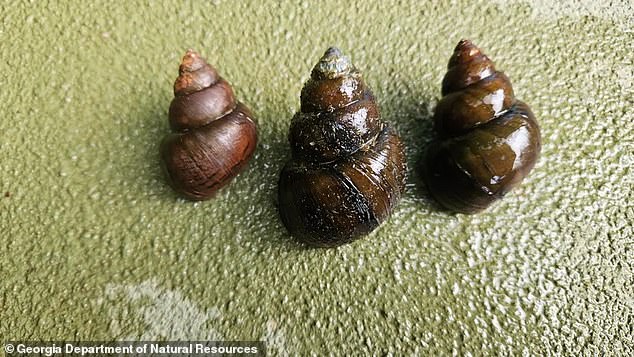Officials sound alarm on invasive Asian ‘mystery snails’ found in Georgia that could be disaster for US economy
Conservationists in Georgia have asked for the public’s help in eradicating a colony of invasive “mystery snails” that harbor dangerous parasites and damage property.
Known as both the ‘Chinese’ and the ‘Japanese mystery snail’, or by its Latin genus CipangopaludinaThe creature was first discovered in the United States at a San Francisco-area fish market in 1892, invasive species experts say.
Many states have made it illegal to release the snails into the wild, while still allowing them to be legally kept in aquariums. But Georgia has adopted stricter rules.
“Recent regulatory changes prohibit individuals from possessing live mystery snails in the State of Georgia,” as Georgia’s Department of Natural Resources Wildlife Resources Division (WRD) reiterated Tuesday, “regardless of their intended use.”
A major concern is that the slimy creatures are known to transmit human intestinal worms and can also carry the same trematode parasites found in native mussels.
Conservationists in Georgia have asked for the public’s help in eradicating a colony of invasive ‘mystery snails’ (pictured), which can harbor dangerous parasites and damage property

Above, an image from the Georgia Department of Natural Resources Wildlife Resources Division (WRD) – which has discovered a ‘viable, reproducing population’ of mystery snails in Lake Lanier
But the mysterious snail can also wreak havoc on private property and “damage ships and other boating equipment,” as Georgia’s WRD noted, as well as potentially clogging water intake pipes of almost any size.
And as other state officials have noted, the economic damage doesn’t stop at man-made structures.
“Mysterious snails can die in large numbers, polluting beaches and coastal areas,” the Minnesota Department of Natural Resources.
The creature’s ecological impact could also impact local fishing results, as the spread of the mysterious snails displaces important species in the food chain.
WRD said the invasive snail was discovered during a routine sampling of Lake Lanier.
“Although we initially hoped this was an individual specimen found on Lanier,” WRD’s Aquatic Nuisance Species Coordinator Jim Page said in a rack‘Further research has shown that this is a viable, reproducing population of snails.’

“While we initially hoped this was an individual specimen found on Lanier,” WRD’s Aquatic Nuisance Species Coordinator Jim Page said in a statement, “further investigation has determined that this is a viable, reproducing population of snails.”

The mysterious snail (pictured) can wreak havoc on private property, “damaging ships and other boating equipment,” as Georgia’s WRD noted, and also potentially clogging water intake pipes of almost any size. Its ecological consequences can also harm local fishing results
Page and his colleagues provided concrete advice to local “fishermen and boaters” in Georgia, asking them to help the state prevent “further spread” of the mysterious snail.
“Prevention remains our best tool in the fight against invasive species, and prevention can only be achieved with the public’s help,” Page said.
“Whether it’s taking time to thoroughly rinse your boat, trailer and fishing gear after every outing,” Page said, “or simply not intentionally releasing non-native species into water bodies where they previously did not exist… Let’s protect our waters!’
The wildlife experts advised that the mysterious snail can be identified by their large size, as they can grow as large as 1.5 to 3 inches between the top and the edge of their shells.
Each scale has 6-7 whorls or spirals and is uniformly olive green to greenish brown or sometimes reddish brown.
A young Chinese mystery snail, experts say, can be as small as a grain of rice. And both adult and young snails can hide in the mud or cling to anchors and ropes, as well as hunting, fishing and diving equipment.
The mysterious snail could reduce the number of beloved local wildlife such as otters, muskrats, ducks, geese and fish because it not only displaces native gastropods and molluscs but also becomes harder to kill as prey.
The mystery snail is one of a number of species whose shell comes with a hatch, which helps seal it off from hungry predators.
Due to the voracious feeding habits of the snails, it tends to alter the chemical and nutrient cycle of aquatic habitats due to the large amount of water. stool it produces.
The resulting increase in nitrogen and phosphorus cycling could lead to disruptive changes in the size of bacteria, algae and zooplankton communities, according to the nonprofit. Invasive Species Center in Ontario, Canada.
For Georgia residents or visitors looking for more information about invasive species and how to report sightings, WRD recommends visiting this address GeorgiaWildlife.com/ans.
